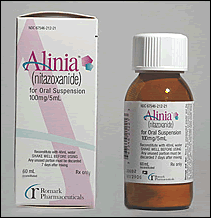| Nitazoxanide
Enhances Anti-HCV Activity of Pegylated interferon/ribavirin and STAT-C Agents By
Liz Highleyman  Researchers
are studying a variety of approaches to improve response to interferon-based
therapy for hepatitis C virus (HCV) infection, including extended duration
therapy and addition of new drugs. Researchers
are studying a variety of approaches to improve response to interferon-based
therapy for hepatitis C virus (HCV) infection, including extended duration
therapy and addition of new drugs.
Studies presented at the recent 59th
Annual Meeting of the American Association for the Study of Liver Diseases (AASLD
2008) in San Francisco looked at adding nitazoxanide (Alinia) to pegylated
interferon and to novel directly-targeted "STAT-C"
agents in the development pipeline.
Jean-Francois Rossignol of Romark
Laboratories and colleagues presented results from a study evaluating a 4 week
lead-in period using nitazoxanide alone, before continuing with nitazoxanide plus
pegylated interferon in patients with HCV
genotype 4, which is considered difficult to treat (lower response rates than
genotypes 2 or 3, slightly
higher than genotype 1).
Nitazoxanide
is a thiazolide anti-infective agent with activity against several protozoa, bacteria,
and viruses. It is FDA approved for treatment of Cryptosporidium and Giardia.
Laboratory studies have shown that nitazoxanide and its active metabolite, tizoxanide,
inhibit HCV replication in vitro.
As background, the investigators
noted that in their previous STEALTH-C1
trial, genotype 4 patients who received nitazoxanide monotherapy for 12 weeks
followed by nitazoxanide plus pegylated interferon alfa, with or without ribavirin,
for 36 weeks responded more rapidly and achieved a higher sustained
virological response (SVR) rate than those receiving standard therapy using
pegylated interferon plus ribavirin
for 48 weeks.
The present study sought to determine whether similar improvement
in outcomes could be obtained with a shorter 4 week nitazoxanide lead-in. The
trial was designed to use data from STEALTH C-1 as a historical control.
This
study included 44 patients enrolled at the University of Tanta in Egypt, where
genotype 4 is the predominant HCV type. Almost all (40 patients) had genotype
4, but 3 had genotype 1, and 1 had genotype 2. Baseline characteristics, including
age, sex, body mass index (BMI), fibrosis stage, and other demographic and disease-related
characteristics were similar to those of patients enrolled in STEALTH C-1.
All
participants received 500 mg twice-daily nitazoxanide monotherapy for 4 weeks,
followed by 180 mcg/week pegylated interferon alfa-2a (Pegasys) plus nitazoxanide
for 36 more weeks (total 48 weeks of treatment); patients did not receive ribavirin.
The primary endpoint was SVR, defined as HCV RNA < 10 IU/mL 24 weeks
after completion of treatment. Secondary endpoints included undetectable HCV RNA
(< 10 IU/mL) at week 4 (rapid virological response or RVR) and week 12 (complete
early virological response or cEVR) after starting combination therapy, as well
as end of treatment response (ETR).
Results
•
In an intent-to-treat analysis,
week 4 RVR rates were as follows:
•
4 week nitazoxanide lead-in +
pegylated interferon: 59%;
•
12 week nitazoxanide lead-in +
pegylated interferon (STEALTH-C1): 54%;
•
12 week nitazoxanide lead-in +
pegylated interferon + ribavirin (STEALTH-C1): 64%;
•
48 week pegylated interferon +
ribavirin (standard therapy): 38%.
•
Week 12 complete EVR rates were
as follows:
•
4 week nitazoxanide lead-in +
pegylated interferon: 82%;
•
12 week nitazoxanide lead-in +
pegylated interferon: 68%;
•
12 week nitazoxanide lead-in +
pegylated interferon + ribavirin: 86%;
•
48 week pegylated interferon +
ribavirin: 70%.
•
ETR rates were as follows:
•
4 week nitazoxanide lead-in +
pegylated interferon: 86%;
•
12 week nitazoxanide lead-in +
pegylated interferon: 71%;
•
12 week nitazoxanide lead-in +
pegylated interferon + ribavirin: 82%;
•
48 week pegylated interferon +
ribavirin: 75%.
•
SVR rates were as follows:
•
4 week nitazoxanide lead-in +
pegylated interferon: 80%;
•
12 week nitazoxanide lead-in +
pegylated interferon: 61%;
•
12 week nitazoxanide lead-in +
pegylated interferon + ribavirin: 79%;
•
48 week pegylated interferon +
ribavirin: 50%.
•
2 of the 3 genotype 1 patients
experienced RVR.
•
All genotype 1 and 2 patients
experienced cEVR, ETR, and SVR.
•
SVR rates were 78% for genotype
4, 100% for genotype 1, and 100% for genotype 2.
•
Adverse events were similar to
those observed in STEALTH C-1.
•
Frequency of side effects was
similar in the nitazoxanide and standard therapy arms.
•
Only 1 patient discontinued therapy,
due to non-compliance.
"The
nitazoxanide lead-in phase used in the STEALTH C-1 trial can be reduced from 12
weeks to 4 weeks without compromising RVR, cEVR, ETR, and SVR rates," the
investigators concluded.
"Results support the need for further studies
of the efficacy of dual therapy with [pegylated interferon] plus nitazoxanide
without ribavirin and suggest similar efficacy of [pegylated interferon] plus
nitazoxanide in patients with genotypes other than genotype 4," they added.
In
another AASLD presentation, Brent Korba of Georgetown University Medical Center
and colleagues described preclinical studies demonstrating synergistic interactions
between nitazoxanide and STAT-C antiviral drugs targeting the HCV NS5B polymerase
(2'C methylcytidine and HCV-796)
and NS3 protease (telaprevir
and BILN-2061) in HCV replicon models. Nitazoxanide
was also active against replicons with mutations conferring resistance to telaprevir-
and 2'C methylcytidine. (Development of HCV-796 and BILN-2061 has been discontinued).
The authors
concluded that nitazoxanide is a good candidate for combination therapies with
STAT-C agents in the absence of interferon or ribavirin. "These
new studies confirm earlier data suggesting synergistic activity between nitazoxanide
and [pegylated interferon] in genotype 4 patients and provide a first look at
sustained virologic response in a limited number of genotype 1 patients,"
Dr. Rossignol said in a press release issued by Romark. "These data also
provide interesting insights into the mechanism of action of nitazoxanide, including
a potential role for its combination with STAT-C drugs, and confirm previous findings
related to its safety." These
data indicate that when using nitazoxanide, ribavirin (which helps prevent relapse)
may not be needed to maintain a sustained response, suggested Romark Chief Medical
Officer and study co-investigator Emmet Keeffe. In
late October, Romark announced completion of enrollment of a U.S. Phase II trial
-- dubbed STEALTH-C3 -- evaluating nitazoxanide with a 4 week lead-in plus pegylated
interferon plus ribavirin in treatment-naive patients with HCV genotype 1, the
most common type in this country. The study includes more than 100 participants,
and data from a planned interim analysis are expected in early 2009. 12/2/08 References
J
Rossignol, A Elfert, EB Keeffe. Evaluation of a 4 Week Lead-In Phase with Nitazoxanide
(NTZ) Prior to Peginterferon (PegIFN) Plus NTZ for Treatment of Chronic Hepatitis
C: Final Report. 59th Annual Meeting of the American Association for the Study
of Liver Diseases (AASLD 2008). San Francisco. October 31-November 4, 2008. Abstract
87/1848.
B Korba, M Elazar, P Liu, and others. Potential Role for Nitazoxanide
in Combination with STAT-C Agents for the Inhibition of HCV Replication without
the Development of Resistance. 59th Annual Meeting of the American Association
for the Study of Liver Diseases (AASLD 2008). San Francisco. October 31-November
4, 2008. Abstract 115.
T Schaninger, J Hong, GG Luo. Nitazoxanide Inhibits
Hepatitis C Virus Replication In Vitro. 59th Annual Meeting of the American Association
for the Study of Liver Diseases (AASLD 2008). San Francisco. October 31-November
4, 2008. Abstract 1000.
Other source
Romark Laboratories. Romark
Announces Presentation of New Data for Nitazoxanide in Chronic Hepatitis C at
AASLD 2008. Press release. November 4, 2008. |

![]()
 Researchers
are studying a variety of approaches to improve response to
Researchers
are studying a variety of approaches to improve response to